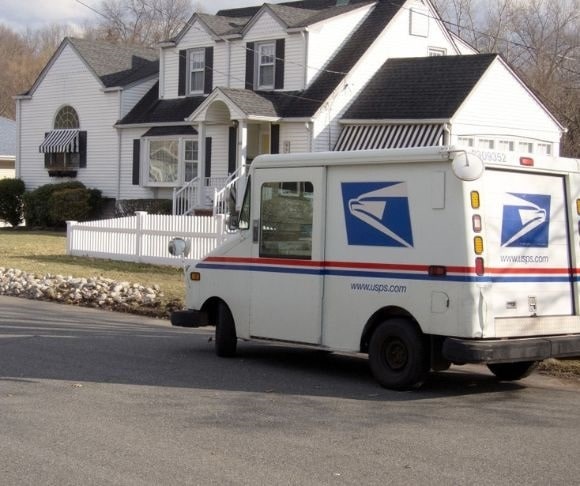
(Photo by Michael Bocchieri/Getty Images)
The United States Postal Service (USPS) has confirmed that the cost-of-living crisis is entrenched in every facet of the US economy. Indeed, USPS inflation has been delivered to Americans’ mailboxes. It now costs more to buy stamps, envelopes, and shipments. But the government’s shipping service, which has faced a bombardment of fiscal challenges over the years, suggested that the American people need to brace themselves for rising costs in the future as the four-decade-high consumer price index (CPI) continues to rise or be sticky. So, how much will it cost starry-eyed senior bobby-soxers to send fan mail to the estates of Clark Gable and William Powell?
USPS Inflation and Your Stamps
As part of its Delivering for America plan, the US Postal Service will charge customers an extra two pennies for their thoughts. Pain at the pump? Think pain at the post office! In order not to be taken aback by the cost of sending Aunt Maude a Christmas card that is a few months late (or early?), here is a list of what everyone can expect to pay:
- A one-ounce First Class Mail letter rate rose two cents to 60 cents. Each extra ounce will cost 24 cents.
- Certified Mail jumped by 25 cents to $4.
- The Metered Rate for First-Class Mail jumped four cents to 57 cents.
- First Class Mail Flats and Large Envelopes edged up four cents to $1.20. Every extra ounce will cost 24 cents.
- A one-ounce First Class Mail International rate swelled ten cents to $1.40.
- Postcards increased by four cents to 44 cents.
 The USPS confirmed that it would assess price adjustments for several other products, including Post Office Box rental fees, the cost of buying insurance to mail packages, and money order charges.
The USPS confirmed that it would assess price adjustments for several other products, including Post Office Box rental fees, the cost of buying insurance to mail packages, and money order charges.
While this nickel-and-diming can hurt the average American in a myriad of ways, the USPS warned that businesses and residents need to prepare for more “uncomfortable” financial pressure every time the public peels off a postage stamp.
While the USPS is increasing First Class Mail prices by 6.5%, this is still below the current inflation rate of 8.6%. When broad-based inflation is plunging the country into a possible recession, it will be harder for the USPS to achieve its ultimate goal of being financially self-sufficient. Should the CPI maintain its escalation, it will be almost impossible for the postal service to balance the books, save for a rainy day, and cover its obligations.
“The mailing industry needs to be prepared for continued use of our authority to raise prices on market dominant products at an uncomfortable rate until such time as we have accomplished our objective of projecting a trajectory that shows us becoming self-sustaining — as required by law,” said Postmaster General Louis DeJoy in May, adding that he will champion raising prices.
The Ten-Year Plan
The USPS is the largest post office in the world. And yet the organization faces a plethora of fiscal difficulties. According to the General Accountability Office (GAO), the postal service lost $69 billion over the last 11 fiscal years. In 2021 alone, the USPS recorded a net loss of $4.9 billion. Presently, in the face of inflation, it is struggling to break even, despite growing revenues by 5% year-over-year to $900 million in the recent quarter.
But how can an entity with incredible market share be losing so much money? Employee compensation accounts for 77% of its operating expenses, which include salary, health benefits, retirement plans, and other related costs. As collective-bargaining agreements and legal requirements strain the institution’s purse, the USPS has raised alarm bells that it might not possess enough pecuniary resources to execute its main mission.

(Photo by Toby Scott/SOPA Images/LightRocket via Getty Images)
One of the proposals presented by the GAO was to “consider the extent to which USPS should be financially self-sustaining and what changes to the law would be appropriate to allow USPS to meet this goal.” There might be a solution: the Delivering for America initiative.
Last year, the USPS unveiled its ten-year, multi-billion-dollar crusade to become fiscally stable, competitive, and modern. The 50-page plan consists of updating package delivery services, investing in new infrastructure, extending greater customer autonomy, enhancing logistical systems, and providing a new suite of products.
“Our plan calls for growth and investments, as well as targeted cost reductions and other strategies that will enable us to operate in a precise and efficient manner to meet future challenges, as we put the Postal Service on a path for financial stability and service excellence,” DeJoy said at the time.
Will this be enough to avert approximately $160 billion in projected losses over the next decade?
End the USPS?
Both sides of the political aisle have attempted to overhaul the USPS for years. Most famously, Senator Elizabeth Warren (D-MA) suggested in July 2019 that the Post Office could function as a bank, known as postal banking. Thankfully, nobody took this bad economic idea seriously. Former President Donald Trump also encouraged a more fiscally responsible agency, ordering an audit of the USPS since it is “on an unsustainable financial path and must be restructured to prevent a taxpayer-funded bailout.” Unfortunately, to anyone with a modicum of understanding of Accounting 101, it is evident that the US Postal Service has been mismanaged for far too long and, like every other arm of the federal government, fallen victim to incompetence, indifference, and intemperance.
Remember to check out the web’s best conservative news aggregator
Whatfinger.com — the #1 Alternative to the Drudge


